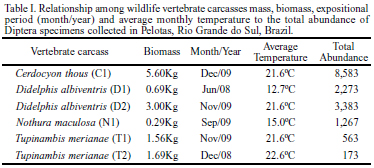Necrophagous Diptera associated with wild animal carcasses in southern Brazil. The aim of this study was to acquire a better knowledge concerning the diversity of necrophagous Diptera that develop on wild animal carcasses. For this purpose, the decomposition of six wild animal carcasses was observed in order to collect and identify the main species of necrophagous flies associated with the decomposition process. The carcasses were found on highways near the cities of Pelotas and Capão do Leão in the initial stage of decomposition, with no significant injuries or prior larval activity. Four wild animal models were represented in this study: two specimens of Didelphis albiventris Lund, 1840; two Tupinambis merianae Linnaeus, 1758; one Nothura maculosa Temminck, 1815; and one Cerdocyon thous Linnaeus, 1766. A total of 16,242 flies from 14 species were reared in the laboratory, where Muscidae presented the greatest diversity of necrophagous species. Overall, (i) carcasses with larger biomass developed a higher abundance of flies and (ii) the necrophagous community was dominated by Calliphoridae, two patterns that were predicted from published literature; and (iii) the highest diversity was observed on the smaller carcasses exposed to the lowest temperatures, a pattern that may have been caused by the absence of the generalist predator Chrysomya albiceps (Wiedemann, 1819). (iv) An UPGMA analysis revealed a similar pattern of clusters of fly communities, where the same species were structuring the groupings.
Calliphoridae; community; diversity; flies; Insecta



